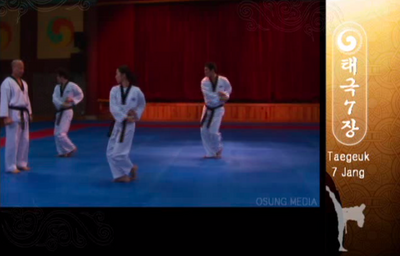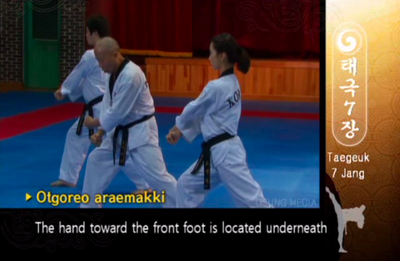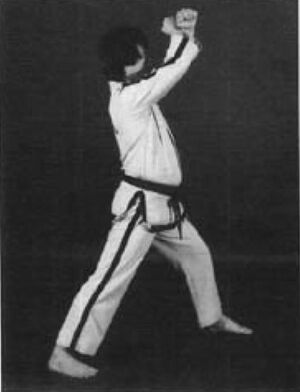
Chambering for a Low Cross Block

A Low Cross Block in Taegeuk Chil Jang
A Cross Block (called an X-Fist Block in ITF-style) is a block in which the wrists are crossed out in front of the body. The palms of the fists face outward, so for example the palm of the right fist is facing left. The wrist on the same side as the leading leg is always on the bottom. The block can be performed in several variations:
- Low, Middle, or High
- With fists or with knifehands
In ITF-style taekwondo, a middle-height Cross Block is called a Checking Block.
Variation: Low Cross Block[]
For a Low Cross Block (also called X-Fist Pressing Block in ITF-style or otgoreo araemagki), the wrists cross at about belt-height. The intent is to block kicks from below.
To chamber for the Low Cross Block, bring both fists to one side of the waist. For example, the left fist is brought back to the waist as if performing a punch, then the right fist is brought back near the left fist. Simultaneously, both wrists are brought forward to cross.
Whichever foot is forward, that should be the wrist that's on top.
Variation: High Cross Block[]

An X-Fist Rising Block in the form Joong-Gun
A High Cross Block (also called X-Fist Rising Block in ITF-style) is a Cross Block that is performed at forehead height. Like a Bull Block, the intent is to deflect blows from above.
Variation: Knifehand Low Cross Block[]
A Knifehand Low Cross Block (sonnal otkoreo arae makgi) is a Low Cross Block that's performed with knifehands. The wrists should be touching and the blades of the hands should be facing downward. The hands are held at groin height. The Knifehand Low Cross Block appears, for instance, in the form Sipjin.
Variation: Knifehand High Cross Block[]
A High Cross Block performed with knifehands. This variation appears, for example, in the form Pyung Ahn Oh-Dan.
Related Techniques[]
References[]
- Low Cross Block on Taekwondo Preschool
- High Cross Block on Taekwondo Preschool